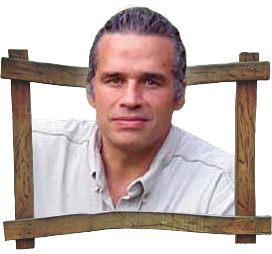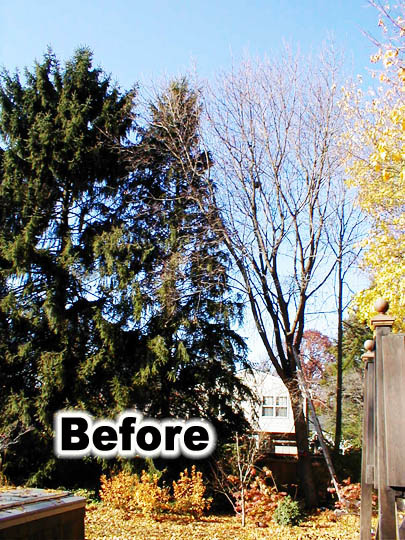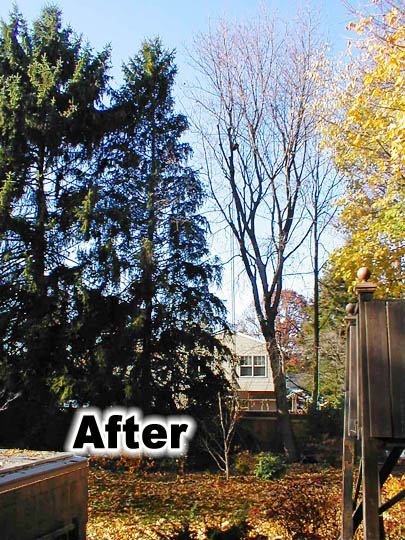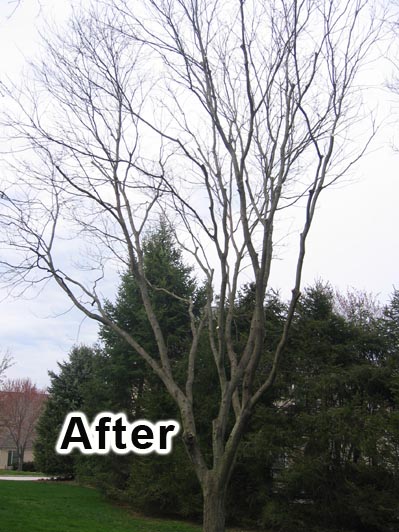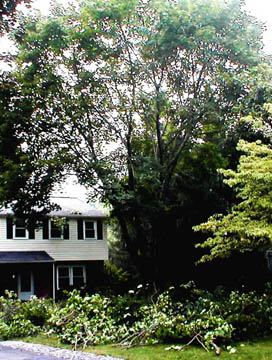~ Daniel Murphy
Pruning is an extremely complicated process because proper pruning techniques will depend greatly on the species of tree, its age and condition, and the purpose of the pruning. In suburban situations big trees have a tendency to outgrown their ability to hold themselves or their branches up becasue they evolved to reach for light in wooded environments, where there is intense competition for light. In the woods trees primarily grow vertically. In “unnaturally” open suburban environments, trees will reach to the side for light, with large horizontal limbs growing towards any sunlit area including houses, lawns, driveways, parking lots and swimming pools etc. And trees keep reaching until they simply cannot support their own weight. A good arborist recognizes this hazard and prunes these long horizontal limbs to reduce weight from the branch tips, where smaller cuts do less damage to trees health and provide the most “bang for the buck” by removing the highly leveraged weight from the tips.
A good arborist also recognizes these and other structural defects such as decay and cracks, and adjusts the amount and distribution of weight to be removed according to the risk of failure and the value of threatened property. In either case pruning is used to reduce the forces on a tree’s structure, thereby reducing the chances of storm damage. Pruning can also be used to “train” young trees. Removing problematic branches while they are young is both cost effective, becasue small trees are easy to prune, and better for the tree’s long term health, becasue smaller pruning cuts are much easier to “heal”.* Though trees do well in the woods, they need attention to develop and maintain good structure in the suburbs.
In other cases pruning is done to meet a human need, whether it be for hazard reduction by removing deadwood, creating clearance from a building or a through-way, creating beauty, shape, and light penetration, or size reduction to help fit in the landscape. Unfortunately due to lack of proper training and inadequate climbing skills, the improper pruning of trees is a common practice in the tree care industry, which has no requirements for training or education.
*Trees do not technically “heal” wounds, as they never replace damaged tissue. Trees “seal” wounds, by growing around the damaged area and put up chemical defenses to inhibit decay, a process called compartmentalization. Trees are easily able to compartmentalize small wounds, while they are frequently unable to compartmentalize large wounds over 4″-6″.
Though the inferior practice of topping has been nearly eradicated, there are still many companies that needlessly elevate trees and/or make large cuts (more than 4-6” in diameter) on the main stems of trees as a routine practice. Though the science has been clear for many years, that these practices can have devastating consequences to a tree’s health; shortening its life span by 50 to 100 years or more, a drive through any neighborhood on the main line will bear testament to the continuing practice of these inferior pruning techniques by many professional tree services, including some of the “household name” companies.
VIDEO PREVIEW
PROPER PRUNING TECHNIQUES
This 12 minute video shows proper pruning techniques on 2 large oaks. This video demonstrates the importance of good climbing skills as well as the importance of a 75′ aerial lift bucket truck in order to reach the outer most branch tips in order to avoid leaving large cuts (wounds) that will cause irreversable decay.
A good climber has the ability to reach the branch tips to make small cuts. This takes more time & energy, but is fat better for the gtree than the common practice of making large cuts on the trees main trunk(s).
I take great care in pruning trees, which includes making many smaller cuts on branch tips, rather than removing large limbs, discouraging clients from removing the lower limbs on mature trees (called elevating or raising the canopy), and also leaving (or at most thinning) water sprouts (often called suckers) whenever aesthetically acceptable. This is progressive pruning and is practiced by only the smallest minority of local tree services. Unfortunately many of my peers are stuck in pruning practices that have been out of favor for nearly 20 years, and have no desire to continue their education or improve their practices.
I AM also extremely careful about not over pruning trees. Trees need their leaves to produce energy to keep themselves vital and healthy, resisting insects and disease, decay, and the stress of harsh winter weather and hot summer droughts. Over-pruning can reduce a tree’s food supply, starting a downward spiral of the tree’s health, which often leads to its premature death, some years later. This is especially true in older tree, which are much more vulnerable to irreparable harm from over-pruning. Large wounds on the trunk will also, over time, result in advanced decay, which will create a hazard that can only be mitigated with removal of the tree. (see video “Melvin Tulip Prune”)
Though many home owners think that young and juvenile trees do not need to be pruned, a quick structural pruning of a young tree is an extremely cost effective way of helping it to develop good structure, which will enable the tree to resist storm damage as it matures, and preclude the need for much more expensive maintenance later in life. Conversely, many homeowners look at their mature trees and think “my trees are too big”, and need to be pruned. Other than removing deadwood and correcting for structural defects, older trees are often better off with little or no pruning, because they need more of their leaves to produce food to keep them healthy, and older trees have a harder time fighting off decay from large pruning wounds. When a mature tree is structurally compromised, proper pruning becomes a balancing act. The arborist needs to reduce weight in the upper canopy in order to reduce stress on the structural defect(s), yet cannot remove too much live branching without hurting the trees ability to produce enough food to keep itself healthy and vital.
Very few arborists have the years of experience, the skill, and the understanding of the above principles, needed to develop and implement a good pruning plan for over mature and structurally compromised trees. Proper pruning of mature trees invariably requires the arborist to make pruning cuts on branch tips, rather than on the main trunk. Reaching the branch tips is much harder and requires the skills and equipment used in advanced climbing techniques to do efficiently and cost effectively. The basic philosophy for proper pruning is to work the tips on each branch and make several smaller cuts (that the tree can easily seal off), rather than removing large branches from the main trunk (which often results in the unstoppable decay of the trunk). Working the branch tips requires advanced tree climbing skills, athleticism and specialized equipment, which include techniques such as foot locking (see Daniel’s article “The Fundamentals and Fine Points of Footlocking” in TCI magazine June 2006) and limb walking. These techniques, which are accomplished with the use of hardware such as ascenders, friction savers (see photos) and advanced friction hitches, are far beyond the experience of the vast majority of tree services and landscaping companies.
Pruning Young Trees
Proper pruning is essential in developing a tree with a strong structure and desirable form. Trees that receive the appropriate pruning measures while they are young will require little corrective pruning when they mature.
Pruning young trees: http://treesaregood.com/treecare/pruning_young.aspx
Pruning Mature Trees
Pruning is the most common tree maintenance procedure. Although forest trees grow quite well with only nature’s pruning, landscape trees require a higher level of care to maintain their safety and aesthetics. Pruning should be done with an understanding of how the tree responds to each cut. Improper pruning can cause damage that will last for the life of the tree, or worse, shorten the tree’s life.
Pruning mature trees: http://treesaregood.com/treecare/pruning_mature.aspx
Small cuts do less damage to the tree than large cuts. For that reason, proper pruning (training) of young trees is critical. Waiting to prune a tree until it is mature can create the need for large cuts that the tree cannot easily close.
Billy Neff, the owner of Main Line Mower and Tree Care Supplies, estimates that fewer than 5% of arborists now serving the main line are using these advanced techniques and equipment, meaning that the other 95% are most likely doing inferior pruning work. It is nearly impossible for the lay person to tell the difference between proper and most inferior pruning. The one inferior practice that can be easily identified by the homeowner is the use of spikes, or climbing spurs, for pruning. These should only be used for removals, and any company that uses climbing spikes to prune trees, even if only occasionally, should be crossed off your list, as they neither care about proper tree care, nor possess the skills to be considered competent in their trade.
Pruning is one area of tree care that homeowners should be careful not to go price shopping on, as inferior pruning may cost less, but it also does irreparable harm to your trees. International Society of Arboriculture (ISA) has a great website with lots of information designed to educate homeowners on proper pruning methods. Included below are excerpts and links to these pages.

